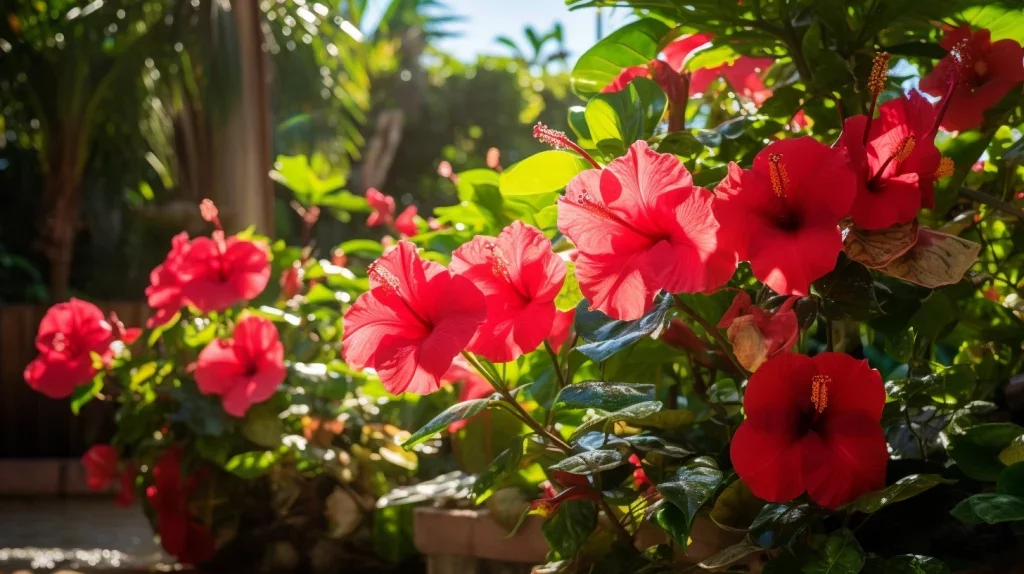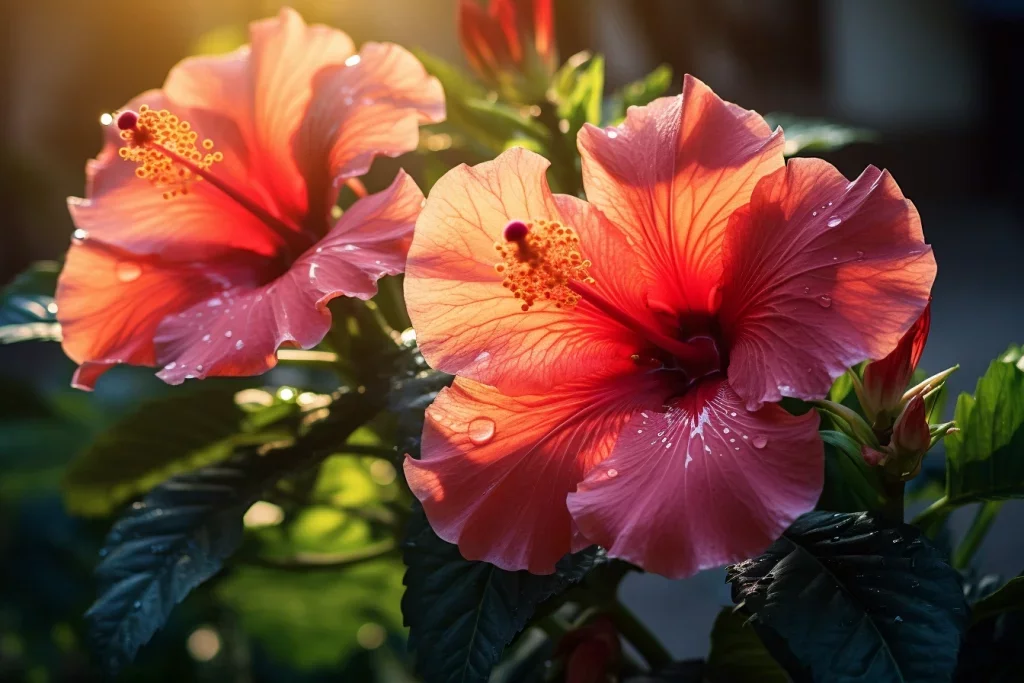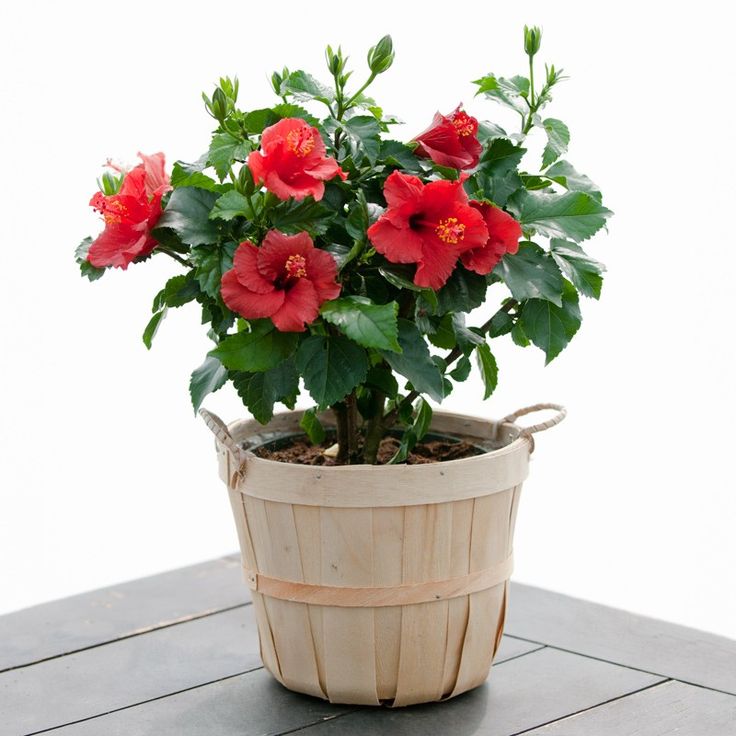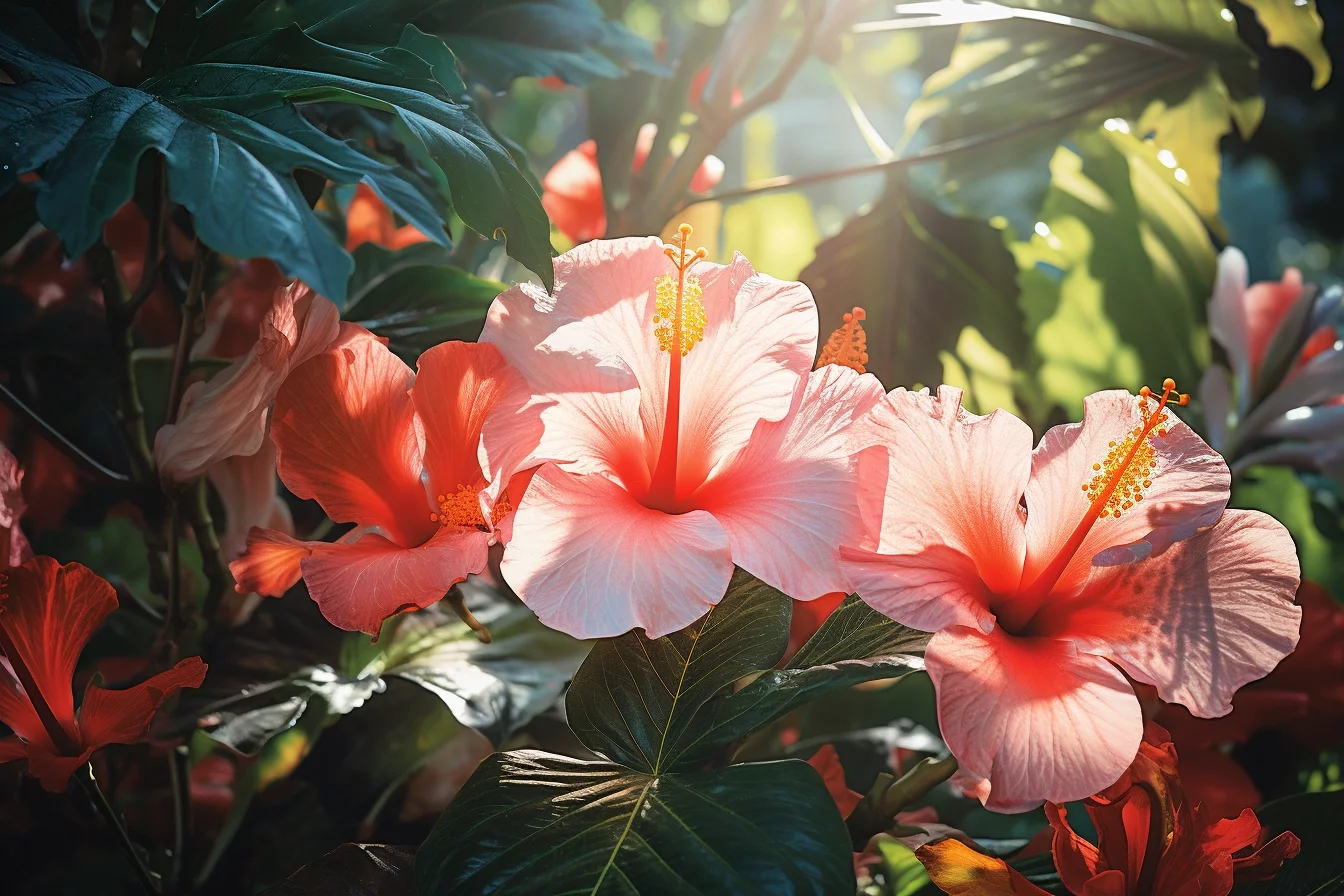Tropical Hibiscus, with its vibrant and flamboyant flowers, is a splendid addition to any indoor garden. Known for their adaptability to container growth and thriving in sub-tropical climates, these plants bring a splash of color and excitement to your indoor spaces. Let’s dive into the world of Tropical Hibiscus, focusing particularly on the stunning Double Peach variety.

Tropical Hibiscus
Flamboyant Flowering Shrubs
Tropical Hibiscus, botanically classified under Hibiscus rosa-sinensis, are renowned for their eye-catching, large, funnel-shaped flowers. They are not just plants but a spectacle of nature’s beauty.
- Centuries of Cultivation: These plants have been cultivated for centuries, valued for their ornamental beauty. They flourish in warm, sub-tropical climates and are incredibly versatile, adapting well to container growth indoors.
- A Spectrum of Colors: The Tropical Hibiscus family boasts an array of flower colors, from classic reds to exotic peaches and yellows, making them a popular choice for adding vibrancy to indoor settings.
Adaptable to Indoor Environments
While traditionally an outdoor plant, Tropical Hibiscus can thrive indoors with proper care. They can bring the essence of a tropical paradise right into your living room, sunroom, or patio.
- Container Growth: With the right container, soil mix, and care regimen, these plants can adapt to indoor conditions, offering their stunning blooms almost all year round.
- Light Requirements: They require bright, indirect light to flourish indoors, mimicking their natural tropical habitat.
| Family | Malvaceae (Mallow family) |
| Native Regions | Warm, temperate, subtropical, and tropical regions worldwide |
| Types of Hibiscus | Tropical Hibiscus and Hardy Hibiscus |
| Tropical Hibiscus Characteristics | Bushy, evergreen shrubs or small trees with large, colorful flowers |
| Flower Description | Large, funnel-shaped, 4-8 in. across, in various colors |
| Blooming Season | Spring through late fall and into winter in frost-free locations |
| Growth Size | 2-30 ft. tall, depending on area and cultivar |
| Sunlight Requirements | Full sun to part shade |
| Soil Requirements | Moist soil, never completely dry |
| Garden Uses | Foundation plantings, shrub borders, flowering hedges, container plants |
| Wildlife Attraction | Attracts butterflies and hummingbirds; deer-resistant |
| Common Pests and Diseases | Aphids, scale, mealybugs, thrips, mites, powdery mildew, downy mildew, botrytis |
| Edible Flowers | Hibiscus rosa-sinensis flowers are edible |
| National Significance | National flower of Malaysia |
Types of Hibiscus
Tropical vs. Hardy Hibiscus
There are two main types of Hibiscus: Tropical Hibiscus and Hardy Hibiscus. Understanding the differences is key to successful cultivation.
- Tropical Hibiscus (Hibiscus rosa-sinensis): These are the typical Hibiscus plants with glossy leaves and a wide range of flower colors. They thrive in warmer zones (10-12) and are not frost-tolerant.
- Hardy Hibiscus: These varieties are more cold-tolerant and can survive in lower temperatures. They might not offer the same color range as their tropical counterparts but are hardier in colder climates.
The Double Peach Hibiscus
One of the most striking varieties in the Hibiscus family is the Double Peach Hibiscus. It is known for:
- Double-Layered Flowers: The Double Peach variety features exquisite, multi-layered blooms that resemble a lush, tropical paradise.
- Color Palette: As the name suggests, the blooms are a soft peach color, often with deeper shades at the center, creating a stunning visual display.
Over 10,000 Hybrids Worldwide
The Hibiscus genus boasts over 10,000 hybrids, each with unique characteristics:
- Hybridization: The extensive hybridization has resulted in a vast array of colors, forms, and sizes. From single to double blooms, the diversity is astounding.
- Versatility: These hybrids have adapted to various climates and conditions, making the Hibiscus family one of the most versatile in the plant kingdom.
Tropical Hibiscus Care
Watering Your Tropical Hibiscus
Ensuring your Tropical Hibiscus receives the right amount of water is crucial for its health and flowering.
Consistent Moisture is Key
- Regular Watering: It’s vital to keep the soil consistently moist but not saturated. A lack of water can impede growth and blooming.
- Daily Watering in Warm Weather: In temperatures ranging from 70-80ºF (21-27ºC), water your Hibiscus daily. In extremely dry conditions, they may need watering twice a day.
- Root-Focused Watering: Direct water to the root system while keeping the foliage as dry as possible to prevent foliar diseases.
- Deep Watering Technique: Ensure each plant is watered thoroughly so the water penetrates the root zone deeply.
- Saucers and Shallow Wells: For container plants, using saucers filled with water or creating a shallow well around in-ground plants can help maintain moisture during hot times.
Reduced Watering in Winter
- Seasonal Adjustments: During winter months, allow the soil to dry out a bit more between watering sessions.
Pruning Your Tropical Hibiscus
Pruning and deadheading are essential for maintaining the shape and promoting blooming in Tropical Hibiscus.
Promoting New Blooms Through Deadheading
- Deadheading: Regularly removing spent blooms will encourage new flower growth.
Shaping and Stimulating Growth
- Best Time to Prune: Prune in early spring as temperatures begin to warm up and new growth buds appear.
- Summer Pruning: In warmer climates, a mid-summer trim can invigorate vigorous shrubs.
- Fall Pruning: In very warm climates, a late fall prune is beneficial, while potted plants brought indoors may need a prune to fit in their winter space.
- Light and Frequent Pruning: For indoor-grown Hibiscus, more frequent light pruning may be necessary.
- Removing Unhealthy Growth: Always cut away any dead or sick branches to maintain plant health.
Fertilizing Your Tropical Hibiscus
Proper fertilization is vital for the health and blooming of your Tropical Hibiscus.
Regular Feeding for Optimal Health
- Feeding Schedule: Fertilize your Hibiscus regularly from spring through fall. Reduce or stop fertilizing in winter.
- Water-Soluble Fertilizers: Use a water-soluble fertilizer with every watering or at least once a week.
- Nutrient Requirements: Hibiscus needs high potassium, low phosphorus, and moderate nitrogen levels. Also, ensure the inclusion of copper, magnesium, and iron.
- Organic Matter: Well-aged compost is beneficial for providing nutrients and promoting soil health.
Propagating Tropical Hibiscus
Propagating your Tropical Hibiscus can be a rewarding experience, allowing you to multiply your beautiful plants.
Propagation by Cuttings
- Cutting Selection: Choose 4-6 inch (10-15 cm) cuttings from strong shoots. Make an angled cut below the node.
- Rooting Hormone Use: Dip the cuttings in rooting hormone before planting in a light potting mixture.
- Maintaining Moisture: Cover the pot with a clear plastic bag to retain moisture and heat.
- Root Development: In 6-8 weeks, cuttings should develop roots and be ready for transplanting.
Pest and Disease Management
While Hibiscus plants are relatively hardy, they can be susceptible to certain pests and diseases.
Common Pests and Diseases
- Watch for Pests: Aphids, scales, mealybugs, thrips, and mites are common pests. Treat them promptly with appropriate measures.
- Disease Prevention: To prevent diseases like powdery mildew, downy mildew, and botrytis, ensure good air circulation and avoid overhead watering.

How to Grow Tropical Hibiscus
Understanding Temperatures for Tropical Hibiscus
Tropical Hibiscus, scientifically referred to as Hibiscus rosa-sinensis, thrives in warm climates and has specific temperature requirements for optimal growth and blooming.
Optimal Temperature Range
- Ideal Conditions: These plants perform best in temperatures ranging from 60-95°F (15-35°C). They flourish in warm environments, making USDA Zones 10-12 ideal for outdoor cultivation.
- Tolerance to High Temperatures: They can withstand temperatures as high as 115°F (46°C), provided they have ample water.
- Cold Sensitivity: Temperatures dropping below 50°F (10°C) can halt their growth and flowering. Prolonged exposure to temperatures under 30°F (-1°C) could be fatal.
Indoor Temperature Considerations
- Indoor Growing: When grown indoors, ensure a warm, sunny spot where daytime temperatures are between 65-75°F (18-24°C) and not lower than 55°F (13°C). Cold drafts should be avoided to prevent bud drop.
Soil and Drainage
The health of Tropical Hibiscus greatly depends on the right soil conditions and effective drainage.
Soil Requirements
- Texture: These plants prefer neutral to slightly acidic, well-drained soils. Sandy loam soil is ideal, offering excellent drainage and aeration.
- Organic Matter: In sandy soils, incorporate decomposed organic matter to improve water retention and soil structure.
- Clay Soils: If dealing with heavy clay, consider raised beds to prevent waterlogging.
Potting Mix for Containers
- Container Growing: Use a rich, loose, well-drained potting mix. A common blend is 80% potting soil with 20% sand to ensure good drainage.
Light Requirements for Double Peach
Light plays a crucial role in the growth and flowering of Tropical Hibiscus.
Outdoor Light Requirements
- Sun Exposure: In northern climates, full sun is beneficial, while in hotter, drier regions, partial shade is preferable to protect from intense sunlight.
- Shade Effects: Too much shade can lead to leggy growth, fewer buds, and reduced flowering.
Indoor Lighting
- Bright Light for Blooming: When grown indoors, Hibiscus requires bright light to bloom prolifically. A sunny western or southern exposure with at least 4-5 hours of direct light is best.
Moisture
Proper watering is essential for Tropical Hibiscus to thrive.
Watering Needs
- Regular Watering: These water-loving plants need consistent moisture during the growing season. Water should be directed to the root system while keeping the foliage dry to reduce the risk of foliar diseases.
- Winter Watering: During the winter months, reduce watering, allowing the soil to dry out slightly between waterings.
Mulching
- Benefits: Mulching around the plants helps retain soil moisture, suppress weeds, and provide root protection during winter.
Planting Instructions
- Planting Depth: When planting, set the Hibiscus in the hole so that the stem is just at the soil surface. Adjust with backfill soil as needed.
- After Planting Care: Water the plant thoroughly after planting and spread mulch around it to maintain moisture and protect the roots.

FAQ: Double Peach Hibiscus (Hibiscus rosa-sinensis) 🌺
1. What is the difference between Hibiscus and Tropical Hibiscus?
The term “hibiscus” broadly refers to plants in the Hibiscus genus, which includes several species. The key differences lie in their growing conditions and appearance:
- Tropical Hibiscus (Hibiscus rosa-sinensis): Known for their large, vibrant flowers, these are native to tropical regions and thrive in warm climates. They typically have glossy leaves and a wide array of flower colors.
- Other Hibiscus Species: This includes varieties like the Hardy Hibiscus, which can tolerate colder temperatures, and the Rose of Sharon (Hibiscus syriacus), which is more shrub-like and less tropical in appearance.
2. How to Overwinter Double Peach Hibiscus?
Overwintering Double Peach Hibiscus, especially in cooler climates, requires some care:
- Indoor Overwintering: If you live in a region where temperatures fall below 50°F (10°C), it’s best to bring the plant indoors before the first frost.
- Reduce Watering: Water less frequently, allowing the soil to dry out slightly between waterings.
- Provide Light: Place the plant in a sunny spot indoors where it can receive ample light.
- Avoid Cold Drafts: Ensure the plant is away from cold windows or drafty areas.
3. Are Tropical Hibiscus poisonous to cats and dogs?
Yes, Tropical Hibiscus, including the Double Peach variety, can be toxic to pets. If ingested, they can cause vomiting, diarrhea, and nausea in cats and dogs. It’s advisable to keep these plants out of reach of pets.
4. How to prune a Tropical Hibiscus?
Pruning Tropical Hibiscus is essential for maintaining shape and encouraging blooming:
- Best Time to Prune: Prune in early spring or late fall, depending on your climate.
- Method: Use clean, sharp shears. Cut back the longer branches and remove any dead or diseased wood.
- Shaping: Aim for a balanced shape that allows light and air to reach the center of the plant.
- Deadheading: Regularly remove spent blooms to encourage new flowers.
5. Are Tropical Hibiscus annuals or perennials?
Tropical Hibiscus, like the Double Peach variety, are perennials in their native tropical climate. However, in cooler regions where they can’t survive the winter outdoors, they are often grown as annuals or brought indoors during the colder months.
6. Do Double Peach Hibiscus like the sun?
Yes, Double Peach Hibiscus loves the sun. They thrive in full sunlight and require several hours of direct sun each day for optimal blooming. In extremely hot climates, some afternoon shade can be beneficial.
7. How long does Tropical Hibiscus last?
The lifespan of a Tropical Hibiscus plant can vary based on care and environment:
- Flower Lifespan: Individual blooms on a Tropical Hibiscus generally last only a day or two.
- Plant Longevity: With proper care, a Tropical Hibiscus plant can live for several years, even decades. Regular pruning, adequate sunlight, proper watering, and appropriate fertilization are key to their longevity.
Megan Stewart, a houseplant aficionado and biologist, resides in the city of Portland, Oregon, USA. Her passion for greenery is matched only by her academic prowess; Megan holds a degree in Biology from the University of Oregon. This background has provided her with a rich understanding of the biological intricacies of plant life, which she skillfully applies to her collection of indoor plants.
Megan's home is a testament to her love for all things green, filled with a diverse array of houseplants ranging from exotic orchids to robust succulents. When she's not tending to her indoor garden, she spends her time with her beloved pets, a constant source of companionship and joy. Her articles are a reflection of her life's passions, offering readers a blend of practical plant care advice, and insightful biological tidbits.
Through her writing, Megan aims to inspire others in the USA and beyond to create their urban jungles and foster a deeper connection with nature.


